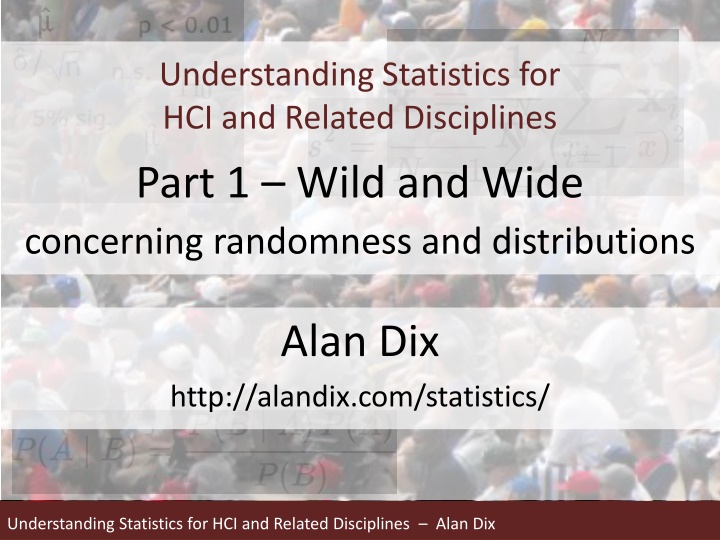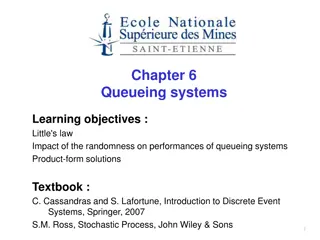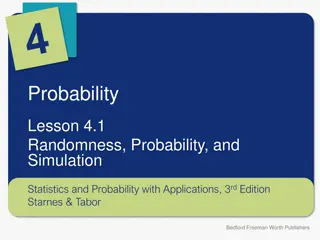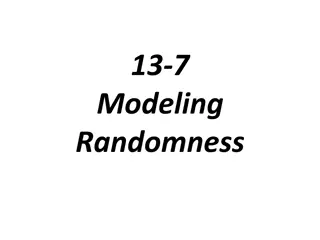Wildness of Randomness: Raindrops and Omens
In a story set in a far-off land, raindrops on stone tiles provide omens. Choose between day 1, day 2, and day 3 to differentiate chance from unusual occurrences. Explore the unexpected wildness of randomness through patterns formed by raindrops. Who knows what each choice signifies - mere chance or mystical omen?
Download Presentation

Please find below an Image/Link to download the presentation.
The content on the website is provided AS IS for your information and personal use only. It may not be sold, licensed, or shared on other websites without obtaining consent from the author.If you encounter any issues during the download, it is possible that the publisher has removed the file from their server.
You are allowed to download the files provided on this website for personal or commercial use, subject to the condition that they are used lawfully. All files are the property of their respective owners.
The content on the website is provided AS IS for your information and personal use only. It may not be sold, licensed, or shared on other websites without obtaining consent from the author.
E N D
Presentation Transcript
Understanding Statistics for HCI and Related Disciplines Part 1 Wild and Wide concerning randomness and distributions Alan Dix http://alandix.com/statistics/ Understanding Statistics for HCI and Related Disciplines Alan Dix
unexpected wildness of random just how random is the world? raindrops and horse races Understanding Statistics for HCI and Related Disciplines Alan Dix
a story In the far off land of Gheisra there lies the plain of Nali. For one hundred miles in each direction it spreads, featureless and flat, no vegetation, no habitation; except, at its very centre, a pavement of 25 tiles of stone, each perfectly level with the others and with the surrounding land. The origins of this pavement are unknown whether it was set there by some ancient race for its own purposes, or whether it was there from the beginning of the world. Rain falls but rarely on that barren plain, but when clouds are seen gathering over the plain of Nali, the monks of Gheisra journey on pilgrimage to this shrine of the ancients, to watch for the patterns of the raindrops on the tiles. Oftentimes the rain falls by chance, but sometimes the raindrops form patterns, giving omens of events afar off. Some of the patterns recorded by the monks are shown on the following pages. Which are mere chance and which foretell great omens? Understanding Statistics for HCI and Related Disciplines Alan Dix
day 1 Understanding Statistics for HCI and Related Disciplines Alan Dix
day 2 Understanding Statistics for HCI and Related Disciplines Alan Dix
day 3 Understanding Statistics for HCI and Related Disciplines Alan Dix
your choice? day 1 day 2 day 3 which are by chance ... and which are unusual? Understanding Statistics for HCI and Related Disciplines Alan Dix
why? . . . Understanding Statistics for HCI and Related Disciplines Alan Dix
which did you choose? day 1 day 2 day 3 chance or omen? Understanding Statistics for HCI and Related Disciplines Alan Dix
day 1 really random empty squares & overfull squares Understanding Statistics for HCI and Related Disciplines Alan Dix
day 2 random but not uniform clumped towards the middle Understanding Statistics for HCI and Related Disciplines Alan Dix
day 3 too uniform every square has 5 rain drops too good to be true! Understanding Statistics for HCI and Related Disciplines Alan Dix
two horse races toss 20 coins add the heads to one row the tails to a second the winner is the first row to 10 before you start: what do you think will happen? Understanding Statistics for HCI and Related Disciplines Alan Dix
the race did you get a clear winner? or was it neck and neck? Understanding Statistics for HCI and Related Disciplines Alan Dix
the world is very random probability head = 0.5 number of tosses number of heads 2 Understanding Statistics for HCI and Related Disciplines Alan Dix
lessons apparent differences may be chance real data has some bad values e.g. Mendel's sweet peas and electron charge discovery were both too good! Understanding Statistics for HCI and Related Disciplines Alan Dix
Understanding Statistics for HCI and Related Disciplines Alan Dix
quick (and dirty!) tip for survey or other count data do square root times two Understanding Statistics for HCI and Related Disciplines Alan Dix
Quick (and dirty!) Tip [1] estimate variation of survey data (for categories with small response) survey 1000 people on favourite colour say 10% of sample say it is blue this represents 100 people variation is roughly 2 x square root of 100 that is about +/- 20 people, or +/- 2% Understanding Statistics for HCI and Related Disciplines Alan Dix
Quick (and dirty!) Tip [2] For response nearer top end the same, but use the number who did not answer Say 85% of sample of 200 say colour is green 15% = 30 people did not say green variation is roughly 2 x square root of 30 that is about +/- 11 people, or +/- 5.5% real value anything from 80 to 90 % Understanding Statistics for HCI and Related Disciplines Alan Dix
Quick (and dirty!) Tip [3] If nearer 50:50 (e.g. presidential election!) then this is a little over estimate, use 1.5 instead Say 50% of sample of 2000 say yes to question 50% = 1000 people did not say green variation is roughly 1.5 x square root of 1000 that is about +/- 50 people, or +/- 2.5% N.B exact formula variance ~ n p (1-p) Understanding Statistics for HCI and Related Disciplines Alan Dix
but really far more important: the fairness of the sample self-selection for surveys the phrasing of the question Understanding Statistics for HCI and Related Disciplines Alan Dix
Understanding Statistics for HCI and Related Disciplines Alan Dix
bias and variability is it fair? is it reliable? Understanding Statistics for HCI and Related Disciplines Alan Dix
bias systematic effects that skew results one way or other e.g. choice of LinkedIn vs. Snapchat survey WEIRD (Western, Educated, Industrialized, Rich, and Democratic) bias persists no matter your sample size but can sometimes be corrected e.g. sample variance hence the n-1 Understanding Statistics for HCI and Related Disciplines Alan Dix
bias vs. variability increase sample size or reduce variability high variability with no bias measurements equally likely to be more or less than real value, but may be far away in either direction poor estimate of right thing low variability with bias Measurements consistent with one another, but systematically one way good estimate of wrong thing eliminate bias or model it Understanding Statistics for HCI and Related Disciplines Alan Dix
Understanding Statistics for HCI and Related Disciplines Alan Dix
independence and non-independence do buses really come in threes? Understanding Statistics for HCI and Related Disciplines Alan Dix
independence different kinds of independence: measurements (normal kind) factor effects sample prevalence non-independence often increases variability but may cause bias too Understanding Statistics for HCI and Related Disciplines Alan Dix
independence measurements measurements may be related to each other: order effects sequential measures on same person (learning, etc.) day effects e.g. sunny day improves productivity experimenter effects your mood effects participants all increase variability Understanding Statistics for HCI and Related Disciplines Alan Dix
independence factor effects Relationships and correlations between things you are measuring (or failing to measure) can confuse causality e.g. death rates often higher in specialist hospitals because more sick people sent there even reverse effects Simpson Paradox Understanding Statistics for HCI and Related Disciplines Alan Dix
Simpsons Paradox You run a course with some full-time and some part-time students You calculate: average FT student marks increase each year average PT student marks also increase each year University complains your marks are going down Who is right? Understanding Statistics for HCI and Related Disciplines Alan Dix
Simpsons paradox you both are! FT students getting higher marks number of PT students increased Understanding Statistics for HCI and Related Disciplines Alan Dix
independence sample the way you obtain your sample internal subjects related to each other e.g. snowball sampling if not external increases variance external subject choice related to topic e.g. measuring age based on mobile app survey may create bias Understanding Statistics for HCI and Related Disciplines Alan Dix
crucial question Is the way I ve organised my sample likely to be independent of the thing I want to measure? e.g. Fitts law with different colour targets. Are student subjects likely to behave differently than the general population? Understanding Statistics for HCI and Related Disciplines Alan Dix
Understanding Statistics for HCI and Related Disciplines Alan Dix
play! experiment with bias and independence http://www.meandeviation.com/tutorials/stats/morecoin.html Understanding Statistics for HCI and Related Disciplines Alan Dix
virtual two horse races virtual race area summary statistics area row counts experiment with biased or or non-independent coins Understanding Statistics for HCI and Related Disciplines Alan Dix
(2) coins automatically added to rows (3) clear coins to play again (1) press to toss a coin Understanding Statistics for HCI and Related Disciplines Alan Dix
coins also appear here for each race summary statistics area row counts appear here modify independence +ve more likely to be same -ve more likely to alternate set bias 0.5 = fair coin Understanding Statistics for HCI and Related Disciplines Alan Dix
more (virtual) coin tossing summary statistics area set number of coins and trials row counts experiment with biased or or non-independent coins Understanding Statistics for HCI and Related Disciplines Alan Dix
nos.of rows of coins press coin to start summary statistics area nos.of coins per row coins appear here row counts appear here set bias 0.5 = fair coin modify independence +ve more likely to be same -ve more likely to alternate Understanding Statistics for HCI and Related Disciplines Alan Dix
fair coin (independent tosses) average close to 50:50 but individual rows vary a lot Understanding Statistics for HCI and Related Disciplines Alan Dix
biased coin (independent) average lower Understanding Statistics for HCI and Related Disciplines Alan Dix
positive correlation (runs) average 50:50 note long runs but variation higher see them swop! Understanding Statistics for HCI and Related Disciplines Alan Dix
negative correlation (alternation) average still 50:50 largely alternate H/T but variation lower very consistent Understanding Statistics for HCI and Related Disciplines Alan Dix
Understanding Statistics for HCI and Related Disciplines Alan Dix
distributions discrete or continuous bounds and tails Understanding Statistics for HCI and Related Disciplines Alan Dix
what kind of data continuous: e.g. time to complete task (12.73 secs) discrete ... arithmetic: ordered/ordinal: .g. satisfaction rating (?average rating?) nominal/categorical: e.g. menu item chosen ( (File+Font)/2 = Flml ?) e.g. number of errors (average makes some sense) Understanding Statistics for HCI and Related Disciplines Alan Dix
finite or unbounded number of heads in 6 tosses discrete, finite number of heads until first tail discrete, unbounded wait before next bus continuous, bounded below (zero), but not above! difference between heights continuous, (sort of) unbounded Understanding Statistics for HCI and Related Disciplines Alan Dix























